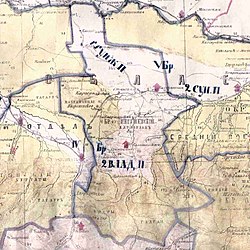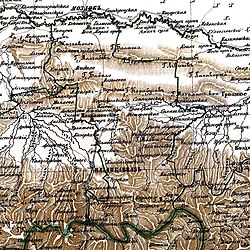Sagopshi
Sagopshi
Сагопши | |
|---|---|
| Other transcription(s) | |
| • Ingush | Соагӏапче |
| Coordinates: 43°29′05″N 44°35′17″E / 43.48472°N 44.58806°E | |
| Country | Russia |
| Federal subject | Ingushetia |
| Founded | 1863 |
| Elevation | 397 m (1,302 ft) |
| Population | |
• Total | 10 048 |
• Estimate (2021)[2] | 12 663 |
| • Subordinated to | Malgobeksky District |
| Time zone | UTC+3 (MSK |
| Postal code(s)[4] | 386340 |
| OKTMO ID | 26615405101 |
Sagopshi (Ingush: Соагӏапче, romanized: Soaghapče;[5] Russian: Сагопши) is a rural locality (a selo) in Malgobeksky District of the Republic of Ingushetia, Russia. Population: 10,048 (2010 Census);[1] 10,738 (2002 Census).[6]
History
[edit]Formation of the village (1863 - 1874)
[edit]In 1863, two new settlements appeared in the mountainous area of Malaya Kabarda, on the river Psygobzhe. The first settlement was called Tsokalo Bokova (Upper Sagopsh) and was inhabited mainly by settlers from Eldarkhan-kala. The second settlement was called Alamkacha Gatagazhev (Lower Sagopsh) and was populated by settlers from the Tarskaya Valley (Abrekovo village).
In 1865, the settlement of Tsokalo Bokov was abandoned due to the migration of its inhabitants to Turkey, and was soon re-populated by the Orstkhoys who remained in their homeland. They gave the settlement a new name, New Akh-Barza.
In 1874, as a result of forced eviction to the plain and the unification of two settlements, the modern village of Sagopshi was formed.[7]
Period of deportation and renaming (1944 - 1957)
[edit]During the period of the deportation of Chechens and Ingush and the abolition of the Chechen-Ingush Autonomous Soviet Socialist Republic (ASSR), the village was called Nogzard and was part of the North Ossetian Autonomous Soviet Socialist Republic.[8]
Return to the original name (1958 - present)
[edit]In 1958, the settlement was returned to its former name, Sagopshi.
Geography
[edit]


The village of Novy Redant is situated in the Alkhanchurt Valley, on the northern slope of the Sunzha Range. It is located 16 km southeast of the district center of the city of Malgobek and 48 km northwest of the city of Magas.
The nearest settlements to Novy Redant include the city of Malgobek to the north, the village of Yuzhnoye to the northeast, the village of Zyazikov-Yurt to the east, the village of Nizhniye Achaluki to the southeast, and the villages of Psedakh and Inarki to the southwest.[9]
Demographics
[edit]| Year | Pop. | ±% |
|---|---|---|
| 1901 | 101,102 | — |
| 1926 | 2,381 | −97.6% |
| 2002 | 10,738 | +351.0% |
| 2006 | 11,221 | +4.5% |
| 2007 | 11,336 | +1.0% |
| 2008 | 11,461 | +1.1% |
| 1956 | 11,646 | +1.6% |
| 2010 | 10,048 | −13.7% |
| 2011 | 10,076 | +0.3% |
| 2012 | 10,360 | +2.8% |
| 2013 | 10,604 | +2.4% |
| 2014 | 10,950 | +3.3% |
| 2015 | 11,247 | +2.7% |
| 2016 | 11,487 | +2.1% |
| 2017 | 11,675 | +1.6% |
| 2018 | 11,918 | +2.1% |
| 2019 | 12,158 | +2.0% |
| 2020 | 12,442 | +2.3% |
| 2021 | 12,663 | +1.8% |
Ethnic composition
[edit]| Ethnicity | Number of people | share |
|---|---|---|
| Inguish | 9,940 | 99.93% |
| other | 108 | 1.07% |
others
[edit]
|
Notable people
[edit]- Sulumbek of Sagopshi — Ingush abrek
References
[edit]- ^ a b Russian Federal State Statistics Service (2011). Всероссийская перепись населения 2010 года. Том 1 [2010 All-Russian Population Census, vol. 1]. Всероссийская перепись населения 2010 года [2010 All-Russia Population Census] (in Russian). Federal State Statistics Service.
- ^ "Таблица 5. Численность населения России, федеральных округов, субъектов Российской Федерации, городских округов, муниципальных районов, муниципальных округов, городских и сельских поселений, городских населенных пунктов, сельских населенных пунктов с населением 3000 человек и более". Всероссийской переписи населения 2020 года
- ^ "Об исчислении времени". Официальный интернет-портал правовой информации (in Russian). June 3, 2011. Retrieved January 19, 2019.
- ^ Почта России. Информационно-вычислительный центр ОАСУ РПО. (Russian Post). Поиск объектов почтовой связи (Postal Objects Search) (in Russian)
- ^ Оздоев 1980, p. 831.
- ^ Federal State Statistics Service (May 21, 2004). Численность населения России, субъектов Российской Федерации в составе федеральных округов, районов, городских поселений, сельских населённых пунктов – районных центров и сельских населённых пунктов с населением 3 тысячи и более человек [Population of Russia, Its Federal Districts, Federal Subjects, Districts, Urban Localities, Rural Localities—Administrative Centers, and Rural Localities with Population of Over 3,000] (XLS). Всероссийская перепись населения 2002 года [All-Russia Population Census of 2002] (in Russian).
- ^ Марьям Яндиева, Адам Мальсагов, «Ингушетия и ингуши», Москва, 1999 г.
- ^ ""PROMETHEUS"". «PROMETHEUS» (in Russian). Retrieved February 11, 2023.
- ^ "Карта Чечни и Ингушетии" (rar). 1995. Archived from the original on July 1, 2012. Retrieved January 2, 2010.rar. Объём 8 МБ.
- ^ "Том 4. Таблица 04-04. Население Ингушетии по национальности и владению русским языком". Archived from the original on March 6, 2016. Retrieved June 4, 2019.
Bibliography
[edit]- Оздоев, И. А. (1980). Оздоева, Ф. Г.; Куркиев, А. С. (eds.). Русско-ингушский словарь: 40 000 слов [Russian-Ingush dictionary: 40,000 words] (in Ingush and Russian). Москва: Русский язык. pp. 1–832.



